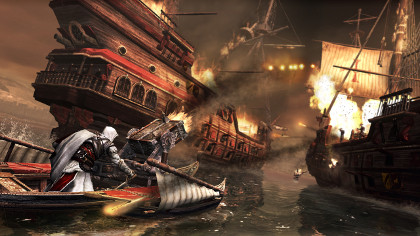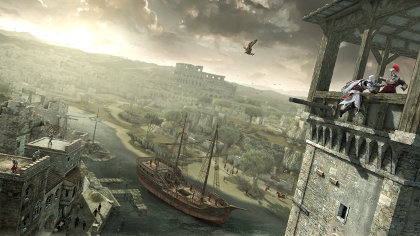Given reasonably regular weapon purchases, the much-criticised counter-kill will take care of anything short of a chap in full plate armour; if the input window has been shortened, it’s been shortened by the barest fraction of a sliver of an atom of a second. A new streak mechanic lets players bully through heavy odds by yanking the stick, Ezio pirouetting from one scripted execution to the next, and should you find yourself short on medicine vials, knives, bolts or bullets, look no further than the pockets of the last guy you murdered.
If the combat’s no more challenging nor intricate, the increased pace which results from AI routines which attack as one at least ensures that victory is swift, and the stylishness of the proceedings can’t be faulted. Ezio’s hidden pistol is now usable in melee, primed by holding a button, and the enlarged suite of motion-captured deathblows should prompt a few appreciative winces.
But Brotherhood’s real appeal lies not in the crunch of spinal columns, the trademark shannng of a hidden blade sliding home or the vengeful satisfactions of hoofing an especially stubborn knight in the balls, but in the bustle of Rome’s markets, bridges and plazas, the shimmering calm of its surrounding grasslands and the mouldering authenticity of its ruins. Assassin’s Creed has never wanted for an eye-catching field of endeavour, and Catholicism’s seat is the series’ most eye-catching to date.

Apparently every other thing old Leo da Vinci designed was a ballistic delivery system. Father of humanism, my arse.
Pretty much every terrain type or furnishing the developers sprinkled across Italy in previous games is enclosed within the capital’s walls. There are wide open spaces, dotted with fallen pillars, forts and small de facto townships, and roofed inner city stairways where civilian traffic slows to a jerkily animated crawl. There’s the tumble-down Circus Maximus, its arches proving tricky customers for the amateur free-runner, the Coliseum, the Obelisk of Montecitorio – all breath-takingly rendered, and all purchasable, would you believe, via the returning economy subgame. The latter is still a pretty token thrill – all you need do to ensure healthy revenues is buy every business you see and visit a bank every twenty minutes – but it’s another excuse to explore, and in Assassin’s Creed: Brotherhood, one should take any excuse to explore.
The environmental richness carries over to the missions. Many of the more throwaway varieties from AC2 – rooftop races, for instance, or bouts of rough-up-the-informant – have been thinned out, the emphasis shifted towards infiltrating encampments in search of bigwigs on whom to whet your blades. Proudest among these are the Borgia tower missions. Twelve such edifices loom over as many districts, and destroying them is requisite if you want to access local missions or facilities and wipe that annoying grey fog off the map screen. While the block-built format threatens to be tedious, the sheer weight of terrain variables coupled with different enemy distributions keeps things memorable. One such mission might send you underground, luring guards off-beat with carefully deposited corpses, while another sees you ambushing the target as he inspects the fortifications.
Story missions have their ups – tailing a nude banker through a festival, with a troupe of courtesans on hand to distract suspicious revellers – and downs – herding a flock of disguised mercenaries through the countryside, dicing checkpoints before anybody cottons on. They’re all much improved, however, by the introduction of a scaled reward system, with optional “repressed memory” missions unlocking if you complete your objectives in just the right fashion. You might be asked to board a ship without getting wet, for instance, or instructed to kill one and but the one man in a sea of crimson dots. These incentives help bold-font parts of the game (e.g. stealth) players might otherwise be tempted to skim, seduced by the one-size-slits-all efficacy of that counter-kill.
A bevy of mostly subterranean jaunts through the temples of Romulus (with some sweet armour as the eventual reward), and a few spells behind the wheels of fanciful Vinci-patented war machines, top off a single player portion that will easily swallow up 20 hours if you chase down the auxiliary content. Brotherhood’s campaign might be short on real ambition, but it certainly isn’t short on options, and if our beta impressions are on the money, the multiplayer should disperse those clouds of familiarity. Stop back soon for a score.
UPDATE: We’ve eaten our fill of Brotherhood online, and put a nice round number at the end of it. Read here.






 Satoru Iwata Video Interview - the late Nintendo president spoke with Kikizo in 2004 as 'Nintendo Revolution' loomed.
Satoru Iwata Video Interview - the late Nintendo president spoke with Kikizo in 2004 as 'Nintendo Revolution' loomed. Kaz Hirai Video Interview - the first of Kikizo's interviews with the man who went on to become global head of Sony.
Kaz Hirai Video Interview - the first of Kikizo's interviews with the man who went on to become global head of Sony. Ed Fries Video Interview - one of Xbox's founders discusses an epic journey from Excel to Xbox.
Ed Fries Video Interview - one of Xbox's founders discusses an epic journey from Excel to Xbox. Yu Suzuki, the Kikizo Interview - we spend time with one of gaming's most revered creators.
Yu Suzuki, the Kikizo Interview - we spend time with one of gaming's most revered creators. Tetris - The Making of an Icon: Alexey Pajitnov and Henk Rogers reveal the fascinating story behind Tetris
Tetris - The Making of an Icon: Alexey Pajitnov and Henk Rogers reveal the fascinating story behind Tetris Rare founders, Chris and Tim Stamper - their only interview? Genuinely 'rare' sit down with founders of the legendary studio.
Rare founders, Chris and Tim Stamper - their only interview? Genuinely 'rare' sit down with founders of the legendary studio. The History of First-Person Shooters - a retrospective, from Maze War to Modern Warfare
The History of First-Person Shooters - a retrospective, from Maze War to Modern Warfare
awsome review,to bad the main campaign it’s so short,but when i think how many sidequest and side missions are, hidden chest and flags and many more stuffs to do,it wort buy and play. What i want to know if there are more locations besides Rome!